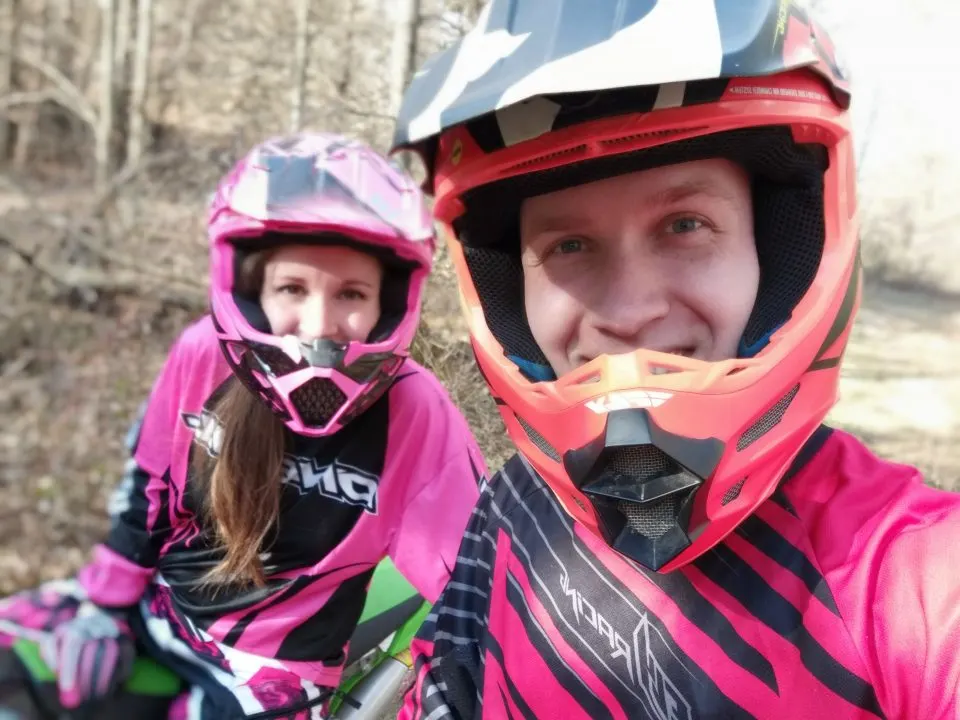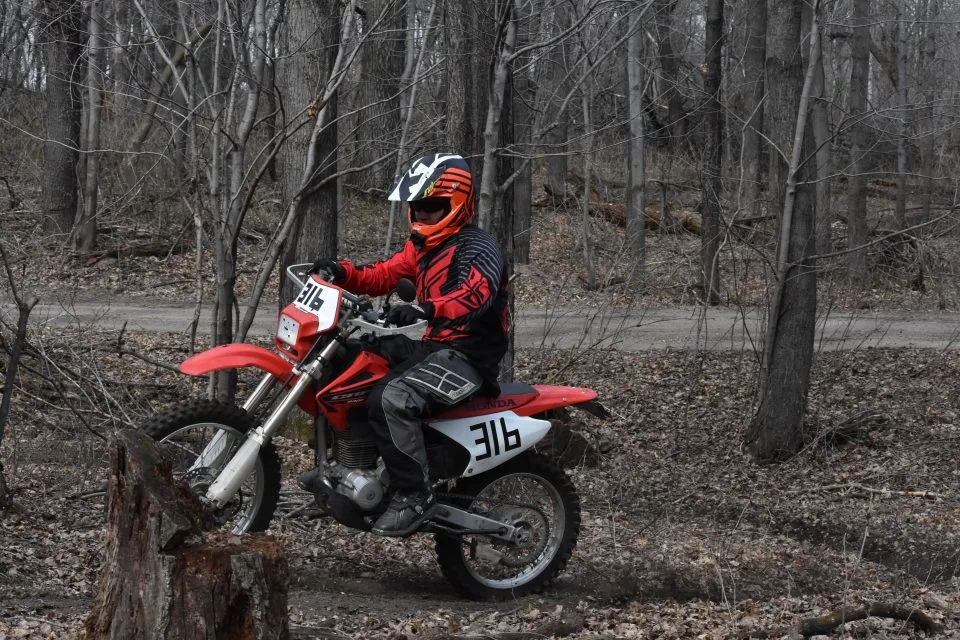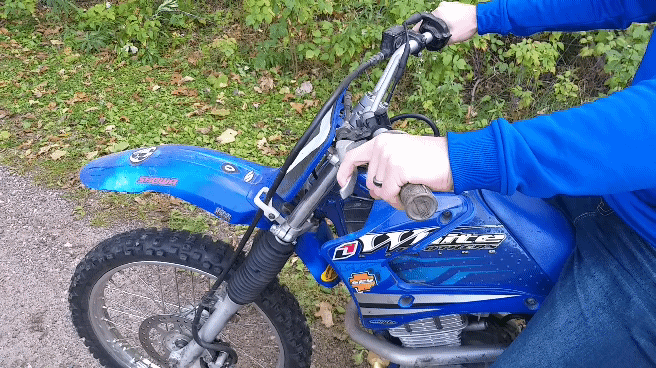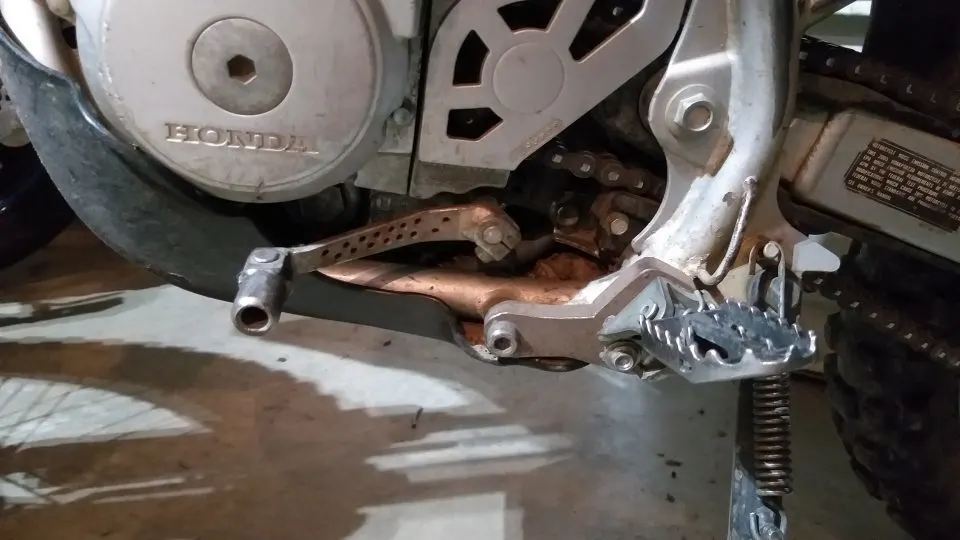Do you want to learn how to ride a dirt bike with a clutch in 4 minutes? What's stopping you? You must learn how to use the clutch, throttle, brake, how to balance, all at the same time… Sound hard?
I want to show you how to simplify everything so you can get to riding as soon as possible! I've taught many first-time riders before, including my wife, and it doesn't matter whether you're young and small, or old and know nothing about dirt bikes.

This step by step guide on how to ride a manual dirt bike for beginners will explain every step of the way, from starting your bike, to using the clutch, throttle, and brakes.
Is It Hard To Ride A Dirt Bike?
Is riding a bicycle hard? If you grew up riding a bicycle, then of course it’s easy now. That’s just not something you forget, which is why the phrase “It’s like riding a bicycle” was coined.
Simply being able to ride a dirt bike is not very difficult, it just takes some proper training to learn the right techniques and then practice.
How To Ride A Dirt Bike In 4 Minutes
Want a quick video on the process of safely riding a dirt bike? Watch this video from the Motocross Hideout youtube channel below, or keep reading.
Enjoy this video? Click here to get free lessons and go more in-depth to become a confident rider!
Would You Do It If I Just Told You?
Say you’re on a plane to go skydiving for the first time and the instructor just hands you a parachute and says “Here you go, jump!” You might back up and say, “No way, I have no idea what I’m doing...”
But if the instructor took just a few minutes beforehand to show you how everything works and what to do if something goes wrong, you’d be more likely to jump out of a perfectly good airplane.
In order to safely ride a dirt bike, you must be able to effectively use the throttle, clutch and brake while balancing on two wheels. It’s really that simple.

Riding Is Easy, Being Good Is Another Story
On the other hand, to be proficient and ride technical single-track trails or on a motocross track at high speeds is very difficult and takes a lot of practice. Learning to be a good dirt bike rider takes hours and hours of seat time.
Just riding your dirt bike will help you figure out how things work. What happens when I give it this much gas and pull up on the handlebars, or if I just slam on the brakes to lock up the wheels? Skill comes with time, and the more you ride, the more you learn, and the more fun it gets.
Is Riding A Dirt Bike Dangerous?
Riding a dirt bike can be very dangerous. There are many ways to get hurt from riding a dirt bike, but if you take just a little extra time to learn, you can keep riding safe and fun.
Riding a dirt bike doesn't have to be much more dangerous than riding a bike on the street or playing football.
Learn More: Ride More
"Learn More, Ride More" is the slogan of Motocross Hideout and it encompasses many aspects of dirt biking. The more you learn how to fix and maintain a dirt bike, the more you'll be able to ride.
The more you learn about how to ride and stay safe, the more you'll be able to ride as well because you won't be crashing all the time.
Riding A Dirt Bike vs Riding An ATV
I actually believe that riding an ATV is more dangerous than a dirt bike. This is simply because an ATV is so much heavier and can more easily land on and crush a rider if tipped over. I have nothing against ATV’s, other than they’re not as fun to ride as a dirt bike.
Start With Proper Riding Gear
You don't need the best gear to be safe, or even every piece of gear when you first start riding. However, riding gear you should have at the very minimum when riding a dirt bike is:
- Dirt bike helmet (lightweight is generally better)
- Riding boots (stiff, above ankle boots is okay to start out)
- Gloves to protect and support your hands
- Long-sleeve clothing that won't rip easily if you tip over
- Goggles or eye protection is important if you are riding with someone or if it's dusty.
To learn more about riding gear and how much you should spend on a full set read this article (coming soon).
Learning The Controls
The first thing you need to do before starting the bike is hop on the seat and learn the controls. The only parts of a dirt bike you need to worry about for now are the gas, clutch, and brake.
The rest of the levers, switches, and buttons are not necessary for learning how to ride a dirt bike at first.
Gas & Brake On The Right
On the right side of the handlebars you have the gas and the brake. The gas, also known as the throttle, you twist back towards you to give it gas. It takes ¼-½ of a turn for the throttle to be 100% open, depending on the bike.

Also on the right side is the front brake lever. Dirt bikes have front and rear brakes, but the only brake you need to focus on for now is the front brake. Try pulling it in a couple times to get the feel of how hard you have to pull.
Clutch On The Left
The lever on the left is the clutch. The clutch is the device that you must use in combination with the throttle to get the bike moving. Learning how to effectively use the clutch is one of the hardest but most rewarding aspects of riding a dirt bike.
Mastering clutch control will put you way ahead of your friends' skill, but let’s first figure out how to use it.
How A Dirt Bike Clutch Works
How the clutch works is actually very simple. Pull the clutch in to “dis-engage” the transmission. This means that when you pull the clutch in all the way the bike cannot accelerate even if you give it gas. Once you shift into gear, the bike can move when you let the clutch out.
When you let the clutch lever out all the way, the clutch will be “fully engaged”. This means that all of the power that the engine is producing will go directly through the transmission, chain and spinning the rear wheel to make the bike move.
How To Use A Clutch On A Dirt Bike
In order to go from stopped to moving, you must “slip the clutch” while it’s in gear. Slipping the clutch is when you let the clutch lever partially out while giving it gas. When you let the clutch out a little bit, the clutch is “partially engaged”.
This means that some of the power of the engine is going through the clutch to the transmission to spin the chain and wheels. The rest of the power is lost in the clutch due to the plates “slipping” across each other. A fully engaged clutch will not have any slipping.
Using The Clutch To Stop
Once you start moving and the clutch is all the way out, you don't need to use it until you want to come to a stop again.
Whenever you want to stop, just remember that you have to pull the clutch in while it's in gear or else the engine will stall when you slow down to a stop.
Basic Steps To Learning How To Ride A Dirt Bike
Okay, so now that you know how the 3 basic features of gas, brake and clutch work, it’s time to put that into a simple process.
How To Start A Dirt Bike
It's time to hop on the bike and get it started. First, turn the gas valve to "ON" (generally located under the left side of the gas tank, as well as the ignition if your bike has it (a key or power button usually located near the handlebars or triple clamps).

E-Start Is Easy Start
If it's an electric start, just turn on the gas and press the starter button on the handlebars. A carbureted dirt bike will need the choke to get it started for a cold start.
How To Kick-start A Dirt Bike
To start a kick-start dirt bike, it's easiest to use your body weight to start it. Always wear riding boots because you can severely injure yourself when using shoes or flip-flops.
To kick start a dirt bike, start it in neutral and don't use the throttle. Find a spot where you can easily touch the ground with your left foot. With the middle of your foot on the kick start lever, push it down until you feel resistance, and then use your body weight to kick it all the way down.
Once started, rotate the kick start lever back in place and let the engine warm up.
For the best tips on how to easily start any dirt bike click here.
Now You're Ready To Roll
Give the throttle a few revs so you know what it feels and sounds like. Mainly just what it sounds like because we as riders like to hear our bike.
Once you're ready to ride, move your butt forward on the seat. This will help prevent a potential "whiskey throttle" from happening.
A whiskey throttle in dirt biking is when the bike starts accelerating or does a wheelie when you don't want it to, but you're so far back on the seat that hanging onto the handlebars twists the throttle more and you quickly loop out.
Finding The "Friction Zone"
Now it's time to get a feel for how the clutch works. Pull the clutch lever in and push the shift lever down into first gear. Don't touch the throttle yet.
The clutch is very sensitive, so very slowly let it out until you feel the bike starting to move. That is the point where the clutch is starting to engage. Pull the clutch back in, and then repeat this process a few times until you're familiar with when the bike will start moving.

Applying Throttle
Now it's time to give it a little gas while letting out the clutch to help get the bike going. You can get the bike going with just letting out the clutch very slowly, but it will stall the engine more easily.
You don't need much throttle to bring the engine RPM up. Just remember to slowly let out the clutch lever. Once you start moving, continue to slowly release the clutch lever.
This is where most new riders fail. Once they start moving they let go of the clutch lever. Instead, you need to gradually let it out while giving it gas until you are moving fast enough to put your feet on the footpegs.
Feeling Out The Clutch
Getting a feel for the clutch is something that you personally have to experience for yourself. The more you try it and practice, the better you will get. It may seem difficult at first, but after some repetition you won't even have to think about it when riding.
This is called building your "muscle memory", which you have done more often than you think. Anything that you physically do that is easy to do without thinking about it is because you built up the muscle memory for doing it.
How To Re-Start The Engine If You Stalled The Bike
Did you get the bike going and start riding? If so, that's awesome! If you stalled the engine, just stay calm and be patient, as it happens all the time. First, you need to get the bike back into neutral gear to start it easily.
How To Find Neutral
To get your bike back into neutral, you will have to shift up if you're in first gear. Neutral is in between first and second gear, so it will only be a "half click" up from first. You may need to roll the bike back and forth several inches if you're having trouble shifting it.

If you lose track of what gear the bike is in, just keep shifting down until it won't shift anymore, then you'll be in first gear again.
Confirming You're In Neutral
To confirm you’ve found neutral, don’t touch the clutch lever and you’ll be able to roll the bike without the rear wheel locking up. If the rear wheel stops, then it’s still in gear.
How To Shift Gears
There are 4 ways to shift gears on a manual dirt bike. We'll look at 2 of those ways because the other 2 are for racing purposes and are harder on the engine/transmission.
Shifting With The Clutch
The first way to shift is by using the clutch. Shifting will feel awkward and slow at first, but after you practice it will be smooth and you won't even have to think about it.
To properly shift with the clutch, follow this sequence:
- Let off the throttle
- Pull in the clutch
- Push up on the shift lever to go up a gear
- Let the clutch lever back out
- Start accelerating again
Yes, there are 5 steps, but a good and solid shift will blend these steps so that you can do it in a matter of one second or less.
Shifting Without The Clutch
Some people may tell you that you need to use the clutch to shift, but that is not true. Their reasoning is that it will damage the transmission, which is also false if you know how to do it properly.
The proper way to shift gears on a dirt bike without the clutch is:
- Let off the throttle
- Shift up by pushing up on the shift lever
- Start accelerating again
The key is to remove the "load" on the transmission before you shift. If you're still accelerating and don't let off the throttle at all when you shift, there's a risk of damaging or bending the shift fork or other transmission parts.
How To Downshift On A Dirt Bike
Downshifting is similar to upshifting gears. Instead of pushing/lifting up on the lever, you simply press down.
You can only shift one gear at a time, so don't press any harder than you need to hear and feel it "click" down a gear.
You can downshift with or without the clutch on a dirt bike. Downshifting with the clutch can be a little smoother because the clutch takes away some of the "jerking" when letting off the throttle or starting to accelerate again.
How to ride a 2 stroke
Riding most 2 stroke dirt bikes requires a little more control because they have less bottom-end torque. This makes the powerband more abrupt and unpredictable, especially if you're just starting out. It's best to scoot forward on the seat and practice rolling on the throttle to get used to the power-curve.
I wouldn't recommend riding in the woods until you're familiar with and comfortable with the clutch, throttle, brakes, and balancing.
Top Mistakes Beginners Make
There’s a lot of mistakes that new riders make because there’s a lot to think about. I believe that you learn best from your own mistakes, but you can learn second best from other people’s mistakes and not repeat them. Here are the most common mistakes that beginner riders make when first learning how to ride a dirt bike:
- Not wearing proper riding gear
- Starting on the wrong dirt bike
- Not having proper instruction (having an instructor in person helps)
- Sitting too far back on the seat
- Letting go of the clutch too quickly
- Not relaxing and having fun
- Not looking ahead (you ride where you look)
- Fear of crashing
Learning how to ride on the right bike for adults and kids is extremely important. Starting out on too big or too powerful of a dirt bike will not only scare a new rider away, but it can seriously hurt you.
I put together a couple different guides to choosing the best beginner bike. This one is for teens and adults, and This one is for kids dirt bikes.
How To Ride Dirt Bike In Different Terrain
Riding a dirt bike is one thing, but riding on different terrain requires proper technique if you want to ride with control and prevent big crashes.
Learning how to use and control the clutch is one of the most important techniques for riding a dirt bike, but there are many other techniques you need to learn to stay balanced and in control no matter what terrain you're riding, and I want to help you get started. Click here to learn proper off-road techniques to give you confidence and control.


R2R@$985
Thursday 27th of February 2025
This blog provides clear, practical advice for beginners learning to ride a dirt bike, breaking down complex skills into simple steps—definitely a must-read for first-time riders!